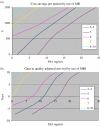Cancer imaging: is it cost-effective?
- PMID: 18250016
- PMCID: PMC1434591
- DOI: 10.1102/1470-7330.2004.0017
Cancer imaging: is it cost-effective?
Abstract
With expenditure on imaging patients with cancer set to increase in line with rising cancer prevalence, there is a need to demonstrate the cost-effectiveness of advanced cancer imaging techniques. Cost-effectiveness studies aim to quantify the cost of providing a service relative to the amount of desirable outcome gained, such as improvements in patient survival. Yet, the impact of imaging on the survival of patients with cancer is small compared to the impact of treatment and is therefore hard to measure directly. Hence, techniques such as decision-tree analysis, that model the impact of imaging on survival, are increasingly used for cost-effectiveness evaluations. Using such techniques, imaging strategies that utilise computed tomography, magnetic resonance imaging and positron emission tomography have been shown to be more cost-effective than non-imaging approaches for the management of certain cancers including lung, prostate and lymphoma. There is stronger evidence to support the cost-effectiveness of advanced cancer imaging for diagnosis, staging and monitoring therapy than for screening. The results of cost-effectiveness evaluations are not directly transferable between countries or tumour types and hence more studies are needed. As many of the techniques developed to assess the evidence base for therapeutic modalities are not readily applicable to diagnostic tests, cancer imaging specialists need to define the methods for health technology assessment that are most appropriate to their speciality.
Figures


Similar articles
-
Modelling Study with an Interactive Model Assessing the Cost-effectiveness of 68Ga Prostate-specific Membrane Antigen Positron Emission Tomography/Computed Tomography and Nano Magnetic Resonance Imaging for the Detection of Pelvic Lymph Node Metastases in Patients with Primary Prostate Cancer.Eur Urol Focus. 2020 Sep 15;6(5):967-974. doi: 10.1016/j.euf.2019.02.013. Epub 2019 Feb 28. Eur Urol Focus. 2020. PMID: 30826284
-
More advantages in detecting bone and soft tissue metastases from prostate cancer using 18F-PSMA PET/CT.Hell J Nucl Med. 2019 Jan-Apr;22(1):6-9. doi: 10.1967/s002449910952. Epub 2019 Mar 7. Hell J Nucl Med. 2019. PMID: 30843003
-
Mammography screening: A major issue in medicine.Eur J Cancer. 2018 Feb;90:34-62. doi: 10.1016/j.ejca.2017.11.002. Epub 2017 Dec 20. Eur J Cancer. 2018. PMID: 29272783
-
Pretherapeutic evaluation of patients with upper gastrointestinal tract cancer using endoscopic and laparoscopic ultrasonography.Dan Med J. 2012 Dec;59(12):B4568. Dan Med J. 2012. PMID: 23290296 Review.
-
Economic evaluation studies in nuclear medicine: the need for standardization.Eur J Nucl Med. 1999 Jun;26(6):663-80. doi: 10.1007/s002590050436. Eur J Nucl Med. 1999. PMID: 10369954 Review.
Cited by
-
Global costs, health benefits, and economic benefits of scaling up treatment and imaging modalities for survival of 11 cancers: a simulation-based analysis.Lancet Oncol. 2021 Mar;22(3):341-350. doi: 10.1016/S1470-2045(20)30750-6. Lancet Oncol. 2021. PMID: 33662286 Free PMC article.
-
Can imaging help improve the survival of cancer patients?Cancer Imaging. 2011 Oct 3;11 Spec No A(1A):S86-92. doi: 10.1102/1470-7330.2011.9022. Cancer Imaging. 2011. PMID: 22185954 Free PMC article. Review.
-
Quantifying Potential Cost-Savings Through an Alternative Imaging-Based Diagnostic Process in Presumptive Seronegative Rheumatoid Arthritis.Clinicoecon Outcomes Res. 2021 Jun 16;13:519-529. doi: 10.2147/CEOR.S302404. eCollection 2021. Clinicoecon Outcomes Res. 2021. PMID: 34168469 Free PMC article.
-
Impact of a Targeted Project for Shortening of Imaging Diagnostic Waiting Time in Patients with Suspected Oncological Diseases in Hungary.Medicina (Kaunas). 2023 Jan 12;59(1):153. doi: 10.3390/medicina59010153. Medicina (Kaunas). 2023. PMID: 36676777 Free PMC article.
-
Incorporating prognostic imaging biomarkers into clinical practice.Cancer Imaging. 2013 Sep 23;13(3):332-41. doi: 10.1102/1470-7330.2013.9003. Cancer Imaging. 2013. PMID: 24060808 Free PMC article. Review.
References
-
- Mackenzie R, Dixon AK. Measuring the effects of imaging: an evaluative framework. Clin Radiol. 1995;50:513–8. - PubMed
-
- Sunshine JH, McNeil BJ. Rapid method for rigorous assessment of radiologic imaging technologies. Radiology. 1997;202:549–57. - PubMed
-
- van Ineveld BM, van Oortmarssen GJ, de Konig HJ, Boer R, van der Maas PJ. How cost-effective is breast cancer screening in different EC countries? Eur J Cancer. 1993;29A:1663–8. - PubMed
-
- Salzmann P, Kerlikowske K, Phillips K. Cost-effectiveness of extending screening mammography guidelines to include women 40 to 49 years of age. Ann Intern Med. 1997;127:955–65. - PubMed
LinkOut - more resources
Full Text Sources
Research Materials
